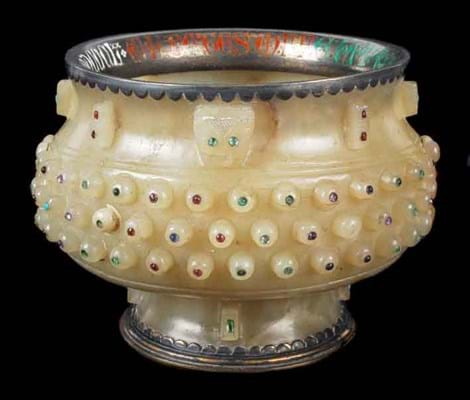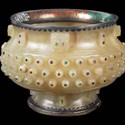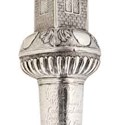In addition to a Puss in Boots pendant estimated at £20,000-30,000 at Woolley & Wallis on October 3, which failed to sell, there have been not one but two examples of a hitherto unknown Burgess brooch, as well as a jewel-decorated robin's-egg-glazed blue flask.
The brooches were apparently made by Burges to mark the wedding of the architect John Pollard to Margaret Seddon in 1864. One sold at Gildings of Market Harborough in August 2011 at £31,000, the other sold by private treaty to the V&A in June. The remarkable flask was sold by the small Wiltshire firm Jubilee Auction Rooms for £42,000 in May.
Another important, and personal, piece emerged at Dreweatts (24% buyer's premium) at Donnington Priory, Newbury last month.
As an antiquarian and an avid collector as well as an architect-designer, Burges often successfully incorporated classical gems, coins, Oriental carvings and porcelain into the art objects he created for himself and his clients.
Like the flask sold by Jubilee in Pewsey, the silver-mounted celadon jade bowl offered at Dreweatts on September 12 was formed around a Chinese work of art. Measuring 3 x 4½in (8 x 11.5cm), the piece was inscribed in capitals Wil Burges Me Fec Honorars Pterdo Se Edinburghse Collastis MDCCCLXX.
Also included in the lot was a typed label from the National Museum of Wales which read Bowl of Indian jade, bought, decorated and inscribed by William Burges (1827-81) who restored Cardiff Castle about 1865, and was the architect for 20, Park Place, Cardiff.
Today's opinion has it that the bowl was Chinese, but there is the possibility that the gemstones (three of them now missing and one chipped) were Mughal Indian.
Dreweatts' vendor was a Welsh collection of some note - the source of the Nantgarw and Swansea porcelain in the saleroom's October ceramics sale.
Estimated at £10,000-15,000, the bowl sold to a London dealer (thought to be bidding for his own collection) at £34,000.
Beadle Staff Head
Another seldom seen object offered in the silver and jewellery catalogue was a 9in (24cm) George I silver beadle's staff head modelled as a church tower with a ball spire.
It had some solder repairs and was marked only with the untraced maker's initials WS but the worn but readable inscription read: This is A Free Gifft Given to Jon. Went by the Parsons under Thos. Wittingham Ch. Warden, Jon. Cole Sideman, Jo. Gosdin, Edw. Wyburd, Constable Peter Lees, Peter Marget, Survaors Jon. Goodwell, Jon, Roulston, Tho. Thorne, Headborroughs, James Smith, Jon. Charpentir.
It carried the name Jon. Went Beadle 1721 beneath.
Beadles were an important part of the courts and livery companies of the City of London - 17th and 18th century staff heads survive in the collections of many of the 'worshipful companies'.
However, the word also came to refer to a parish constable of the Anglican Church. Often charged with duties of charity including overseeing the parish workhouse and orphanage, they were given a bad name by Dickens's Mr Bumble in Oliver Twist.
One trusts Jon. Went was a much finer fellow.
With its inscription and distinctive form (suggesting it was modelled on a specific building), this ecclesiastical staff head, from an era when so many of London's churches were built, offers plenty of possibilities for research.
Acquired by the vendor around 20 years ago, it sold to a London dealer at £3500 (estimate £800-1200).








